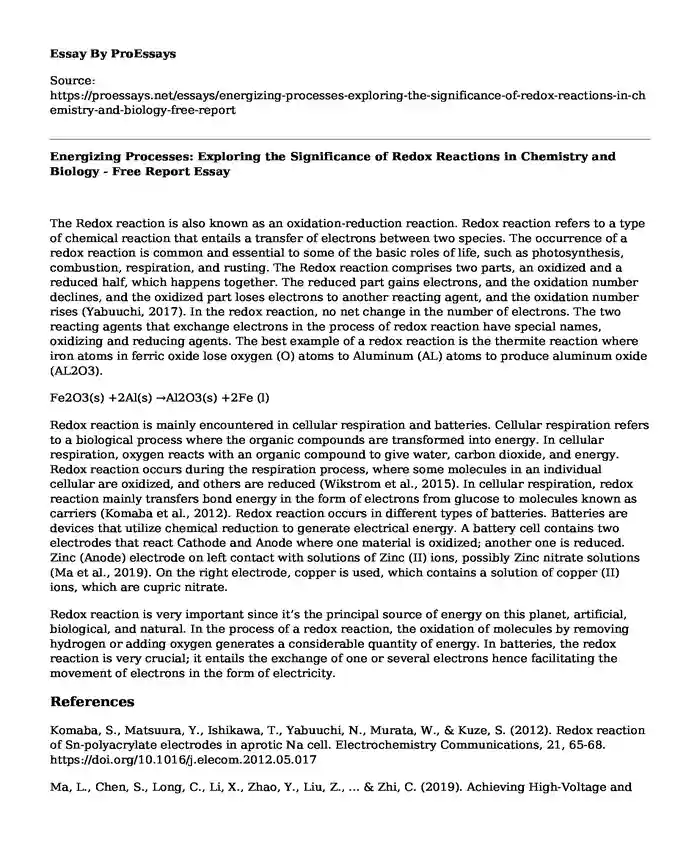The Redox reaction is also known as an oxidation-reduction reaction. Redox reaction refers to a type of chemical reaction that entails a transfer of electrons between two species. The occurrence of a redox reaction is common and essential to some of the basic roles of life, such as photosynthesis, combustion, respiration, and rusting. The Redox reaction comprises two parts, an oxidized and a reduced half, which happens together. The reduced part gains electrons, and the oxidation number declines, and the oxidized part loses electrons to another reacting agent, and the oxidation number rises (Yabuuchi, 2017). In the redox reaction, no net change in the number of electrons. The two reacting agents that exchange electrons in the process of redox reaction have special names, oxidizing and reducing agents. The best example of a redox reaction is the thermite reaction where iron atoms in ferric oxide lose oxygen (O) atoms to Aluminum (AL) atoms to produce aluminum oxide (AL2O3).
Fe2O3(s) +2Al(s) →Al2O3(s) +2Fe (l)
Redox reaction is mainly encountered in cellular respiration and batteries. Cellular respiration refers to a biological process where the organic compounds are transformed into energy. In cellular respiration, oxygen reacts with an organic compound to give water, carbon dioxide, and energy. Redox reaction occurs during the respiration process, where some molecules in an individual cellular are oxidized, and others are reduced (Wikstrom et al., 2015). In cellular respiration, redox reaction mainly transfers bond energy in the form of electrons from glucose to molecules known as carriers (Komaba et al., 2012). Redox reaction occurs in different types of batteries. Batteries are devices that utilize chemical reduction to generate electrical energy. A battery cell contains two electrodes that react Cathode and Anode where one material is oxidized; another one is reduced. Zinc (Anode) electrode on left contact with solutions of Zinc (II) ions, possibly Zinc nitrate solutions (Ma et al., 2019). On the right electrode, copper is used, which contains a solution of copper (II) ions, which are cupric nitrate.
Redox reaction is very important since it’s the principal source of energy on this planet, artificial, biological, and natural. In the process of a redox reaction, the oxidation of molecules by removing hydrogen or adding oxygen generates a considerable quantity of energy. In batteries, the redox reaction is very crucial; it entails the exchange of one or several electrons hence facilitating the movement of electrons in the form of electricity.
References
Komaba, S., Matsuura, Y., Ishikawa, T., Yabuuchi, N., Murata, W., & Kuze, S. (2012). Redox reaction of Sn-polyacrylate electrodes in aprotic Na cell. Electrochemistry Communications, 21, 65-68. https://doi.org/10.1016/j.elecom.2012.05.017
Ma, L., Chen, S., Long, C., Li, X., Zhao, Y., Liu, Z., ... & Zhi, C. (2019). Achieving HighVoltage and HighCapacity Aqueous Rechargeable Zinc Ion Battery by Incorporating TwoSpecies Redox Reaction. Advanced Energy Materials, 9(45), 1902446.
Wikstrom, M., Sharma, V., Kaila, V. R., Hosler, J. P., & Hummer, G. (2015). New perspectives on proton pumping in cellular respiration. Chemical Reviews, 115(5), 2196-2221. https://doi.org/10.1021/cr500448t
Yabuuchi, N. (2017). The solid-state redox reaction of oxide ions for rechargeable batteries. Chemistry Letters, 46(4), 412-422. https://doi.org/10.1246/cl.161044
Cite this page
Energizing Processes: Exploring the Significance of Redox Reactions in Chemistry and Biology - Free Report. (2023, Dec 16). Retrieved from https://proessays.net/essays/energizing-processes-exploring-the-significance-of-redox-reactions-in-chemistry-and-biology-free-report
If you are the original author of this essay and no longer wish to have it published on the ProEssays website, please click below to request its removal:
- Missouri's Role in the Civil War
- Serbia: Country Analysis. Report Sample.
- A Discussion on Respiratory System Paper Example
- Essay Sample on Humans and Nature: A Path to Sustainability
- Free Essay Sample on Natural Capital: Essential for Human Survival
- Understanding Varicose Vein Problems - Free Report Example
- Report Example on Management of Stormwater







